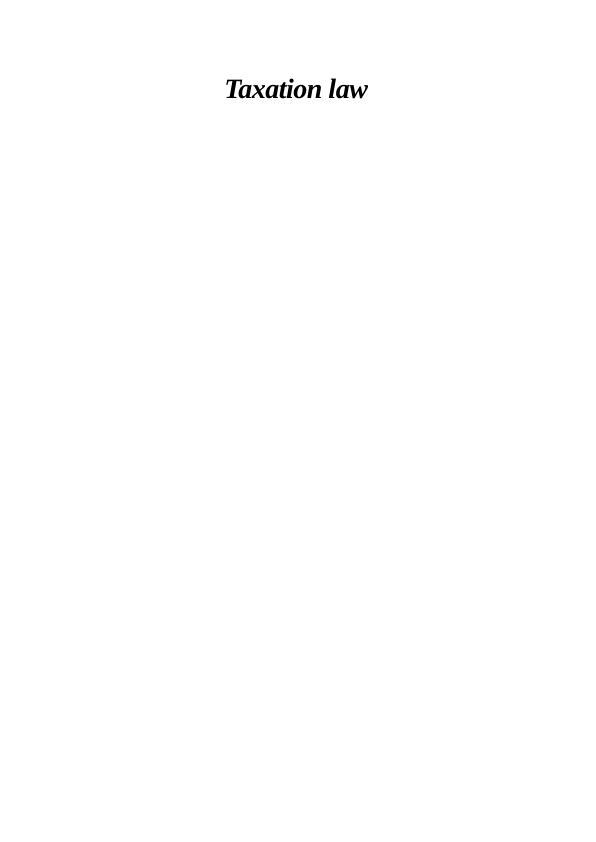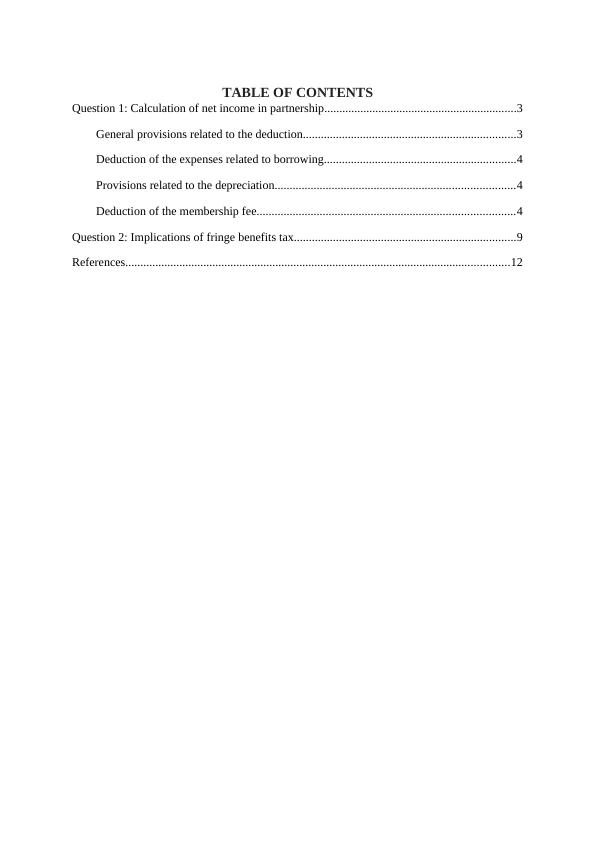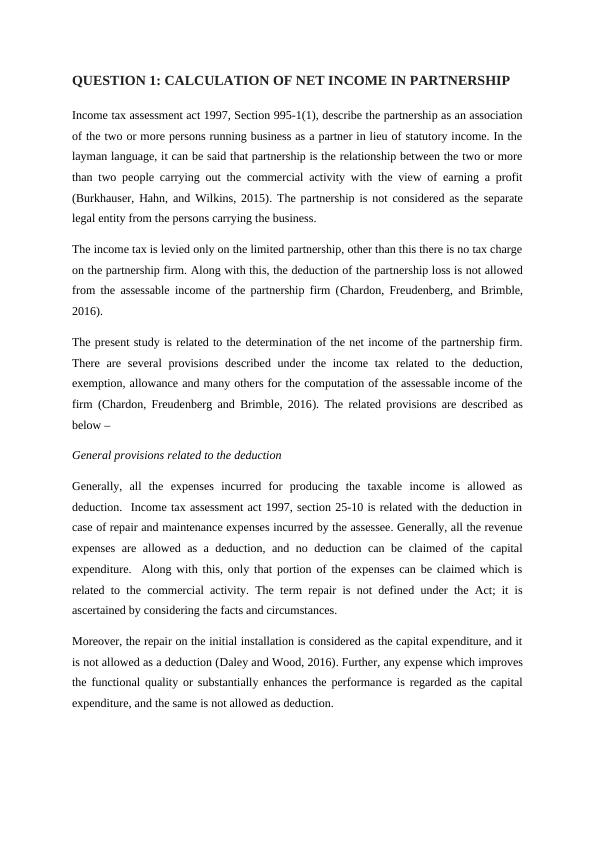Partnership Net Income Calculation: Taxation Law Explained
Added on 2023-04-24
13 Pages2786 Words127 Views
Taxation law

TABLE OF CONTENTS
Question 1: Calculation of net income in partnership................................................................3
General provisions related to the deduction.......................................................................3
Deduction of the expenses related to borrowing................................................................4
Provisions related to the depreciation................................................................................4
Deduction of the membership fee......................................................................................4
Question 2: Implications of fringe benefits tax..........................................................................9
References................................................................................................................................12
Question 1: Calculation of net income in partnership................................................................3
General provisions related to the deduction.......................................................................3
Deduction of the expenses related to borrowing................................................................4
Provisions related to the depreciation................................................................................4
Deduction of the membership fee......................................................................................4
Question 2: Implications of fringe benefits tax..........................................................................9
References................................................................................................................................12

QUESTION 1: CALCULATION OF NET INCOME IN PARTNERSHIP
Income tax assessment act 1997, Section 995-1(1), describe the partnership as an association
of the two or more persons running business as a partner in lieu of statutory income. In the
layman language, it can be said that partnership is the relationship between the two or more
than two people carrying out the commercial activity with the view of earning a profit
(Burkhauser, Hahn, and Wilkins, 2015). The partnership is not considered as the separate
legal entity from the persons carrying the business.
The income tax is levied only on the limited partnership, other than this there is no tax charge
on the partnership firm. Along with this, the deduction of the partnership loss is not allowed
from the assessable income of the partnership firm (Chardon, Freudenberg, and Brimble,
2016).
The present study is related to the determination of the net income of the partnership firm.
There are several provisions described under the income tax related to the deduction,
exemption, allowance and many others for the computation of the assessable income of the
firm (Chardon, Freudenberg and Brimble, 2016). The related provisions are described as
below –
General provisions related to the deduction
Generally, all the expenses incurred for producing the taxable income is allowed as
deduction. Income tax assessment act 1997, section 25-10 is related with the deduction in
case of repair and maintenance expenses incurred by the assessee. Generally, all the revenue
expenses are allowed as a deduction, and no deduction can be claimed of the capital
expenditure. Along with this, only that portion of the expenses can be claimed which is
related to the commercial activity. The term repair is not defined under the Act; it is
ascertained by considering the facts and circumstances.
Moreover, the repair on the initial installation is considered as the capital expenditure, and it
is not allowed as a deduction (Daley and Wood, 2016). Further, any expense which improves
the functional quality or substantially enhances the performance is regarded as the capital
expenditure, and the same is not allowed as deduction.
Income tax assessment act 1997, Section 995-1(1), describe the partnership as an association
of the two or more persons running business as a partner in lieu of statutory income. In the
layman language, it can be said that partnership is the relationship between the two or more
than two people carrying out the commercial activity with the view of earning a profit
(Burkhauser, Hahn, and Wilkins, 2015). The partnership is not considered as the separate
legal entity from the persons carrying the business.
The income tax is levied only on the limited partnership, other than this there is no tax charge
on the partnership firm. Along with this, the deduction of the partnership loss is not allowed
from the assessable income of the partnership firm (Chardon, Freudenberg, and Brimble,
2016).
The present study is related to the determination of the net income of the partnership firm.
There are several provisions described under the income tax related to the deduction,
exemption, allowance and many others for the computation of the assessable income of the
firm (Chardon, Freudenberg and Brimble, 2016). The related provisions are described as
below –
General provisions related to the deduction
Generally, all the expenses incurred for producing the taxable income is allowed as
deduction. Income tax assessment act 1997, section 25-10 is related with the deduction in
case of repair and maintenance expenses incurred by the assessee. Generally, all the revenue
expenses are allowed as a deduction, and no deduction can be claimed of the capital
expenditure. Along with this, only that portion of the expenses can be claimed which is
related to the commercial activity. The term repair is not defined under the Act; it is
ascertained by considering the facts and circumstances.
Moreover, the repair on the initial installation is considered as the capital expenditure, and it
is not allowed as a deduction (Daley and Wood, 2016). Further, any expense which improves
the functional quality or substantially enhances the performance is regarded as the capital
expenditure, and the same is not allowed as deduction.

As per the legal case law of Kitto J in W Thomas, expenditure incurred for maintenance of
the income-generating asset is considered as the revenue expenditure, and the same can be
claimed as a deduction.
Deduction of the expenses related to borrowing
All the expenses related to the borrowing are allowed as deduction if the borrowing is used
for the business. Generally, the expenses can be claimed during the term of the loan. The
payment of interest is allowed as a deduction (Doerrenberg, Peichl, and Siegloch, 2017).
Provisions related to the depreciation
Depreciation is allowed as a deduction from the income of the assessee. There is two methods
by which the depreciation can be computed, which are the prime cost method and the
diminishing value method (Feldstein, 2015).
Depreciation by the prime cost method
Cost of the asset*(days held/365)*100%/effective life of the asset
Depreciation by diminishing value method
If the asset is purchased before 10May 2006
Base Value*(days held/365)*150%/effective life of the asset
If the asset is purchased after 9 May 2006
Base Value*(days held/365)*200%/effective life of the asset
The income tax act prescribes the effective life of the asset separately, which is considered
while calculating the depreciation.
Deduction of the membership fee
Any payment related to the membership is allowed as a deduction only if the partner is the
member of that particular union.
the income-generating asset is considered as the revenue expenditure, and the same can be
claimed as a deduction.
Deduction of the expenses related to borrowing
All the expenses related to the borrowing are allowed as deduction if the borrowing is used
for the business. Generally, the expenses can be claimed during the term of the loan. The
payment of interest is allowed as a deduction (Doerrenberg, Peichl, and Siegloch, 2017).
Provisions related to the depreciation
Depreciation is allowed as a deduction from the income of the assessee. There is two methods
by which the depreciation can be computed, which are the prime cost method and the
diminishing value method (Feldstein, 2015).
Depreciation by the prime cost method
Cost of the asset*(days held/365)*100%/effective life of the asset
Depreciation by diminishing value method
If the asset is purchased before 10May 2006
Base Value*(days held/365)*150%/effective life of the asset
If the asset is purchased after 9 May 2006
Base Value*(days held/365)*200%/effective life of the asset
The income tax act prescribes the effective life of the asset separately, which is considered
while calculating the depreciation.
Deduction of the membership fee
Any payment related to the membership is allowed as a deduction only if the partner is the
member of that particular union.

End of preview
Want to access all the pages? Upload your documents or become a member.
Related Documents
Essay On Steps To Calculate Taxeslg...
|12
|2780
|28
Taxation Theory, Practice & Law: Individual Assignment T3 2018lg...
|11
|2515
|409
Australian Taxation: Assessable Income of Partnership Business, Depreciating Assets, Repairs and Maintenance, Loss in Partnershiplg...
|10
|1868
|365
Taxation Law: Provisions of Partnership Taxation and FBT Explainedlg...
|11
|2214
|288
Specific Deduction Question Answer 2022lg...
|12
|2670
|13
Assessment of Income and Deductions under Income Tax Assessment Act 1997lg...
|7
|2253
|329
